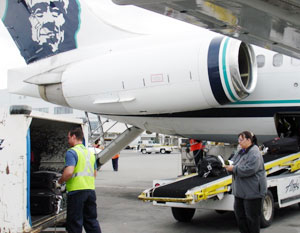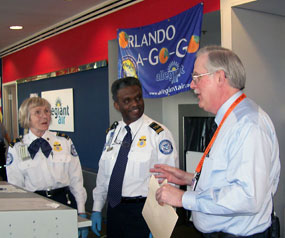TSA's First 300: Still Making a Mark
News & Happenings
June 5, 2007

The Mobile Screening Force was a launching pad to
other jobs for many of its members. Here, Aviation
Security Inspector Milica Wilson, a member of the
first MSF class, at Alaska's Ted Stevens Anchorage
International Airport.
It was mid-2002 and after weeks of training it was time for the Mobile Screening Force (MSF) to roll out New York's John F. Kennedy International Airport, putting in gear a fast-paced schedule of training screeners to meet the near-impossible challenge of federalizing airports across the country.
"We were like the nameless, faceless second lieutenants that parachuted into Normandy on D-Day during World War II," said Robert Nunnery. "Nobody will ever remember our names, but no one will ever forget what we did."
Like many on the MSF – which also constituted an elite group of screening instructors – that experience helped shape Nunnery's career at TSA. He is now assistant federal security direcctor at Shreveport (La.) Regional Airport.
And Milica Wilson, a former MSF supervisor, is now an aviation security inspector in Alaska. She recalled times when she was the only female in her area at Baltimore/Washington International Thurgood Marshall Airport (BWI), working 20-hour days as she simultaneously trained screeners and worked the checkpoint. "I loved every minute," she said.
Another common denominator of the former MSF members is coming to TSA out of a duty to country in the wake of the September 11, 2001, terrorist attacks. "I understood the challenges of the days, months and years to come," said Wilson, a 16-year veteran of law enforcement and Army Intelligence before joining TSA. "Those of us that understood this took it all in stride."
In March 2002, the first MSF class of 300 was sworn in.

From left, TSO Brenda Thomas, Supervisory TSO
Earl Harden and Assistant FSD Robert Nunnery at
Louisiana's Shreveport Regional Airport.
The MSF trained at the Federal Aviation Administration academy in Oklahoma City. One evening they were taken to the memorial of the Alfred P. Murrah Federal Building where 168 lives were lost in what then had been the deadliest terrorist attack on American soil.
"Being in the center of the memorial at twilight and watching the lights brighten on each chair was poignant and reinforced my decision to serve again," Wilson said.
The MSF federalized Baltimore/Washington International piers A and B in April 2002, then studied what worked and what did not as they returned to their home airports and waited to begin the dash to bring TSA into more than 400 airports. All passengers were being screened by November as was all baggage by the end of the year – deadlines set by Congress.
Looking back on those days as an MSF supervisor, Karen Steer, now on the mobile technical assistance team in the Office of Operational and Technical Training, said, "it was exciting knowing that we were making history and that it was up to us to mold the new screening force."
The MSF was the genesis of today's National Deployment Force (NDF) and Transportation Security Officer Volunteers (TSOVs) that respond to seasonal demands, special security events and other circumstances – like Hurricane Katrina – that require more personnel at airports. More than 1,500 TSA employees have been part of those special deployment forces.
Ron Stephens, also of the first MSF class and now a senior security manager at Seattle-Tacoma International Airport, said special deployments have contributed to the agency's growth, to standing on "our own two feet." MSF set an early standard for how to get tough jobs done, he said.


